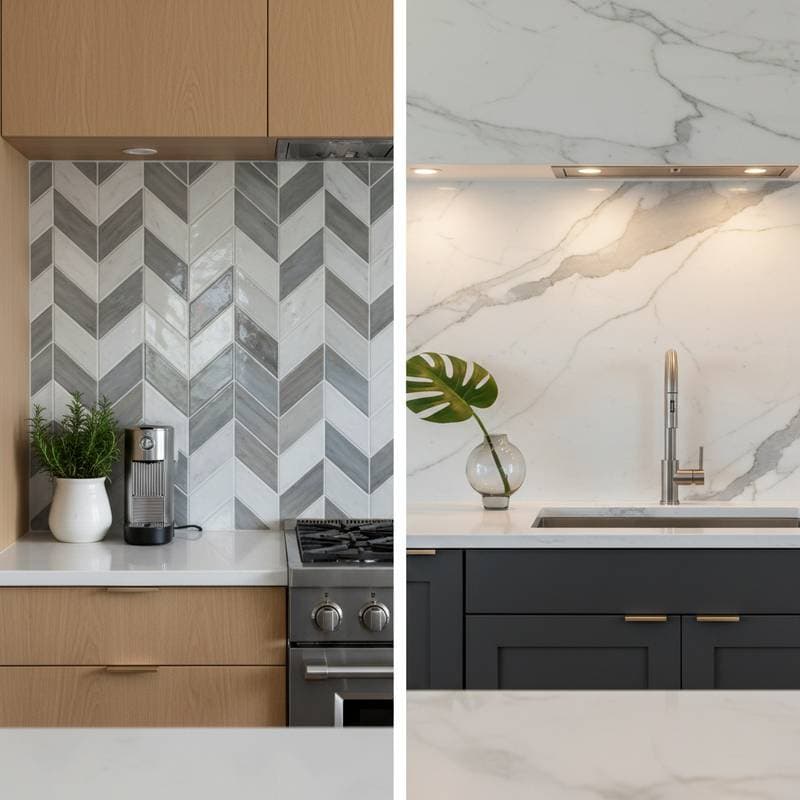Key Takeaways
- Tile backsplashes provide a cost-effective option with extensive design variety and straightforward installation, ideal for updates that enhance resale value without significant expense.
- Slab backsplashes present a seamless, premium appearance that elevates the perceived quality of modern and upscale kitchens.
- Achieving optimal return on investment in 2025 requires aligning the backsplash selection with the kitchen's existing style, available budget, and anticipated buyer preferences.
Highlights
- Tile backsplashes prove budget-friendly, allow extensive customization through patterns and colors, and facilitate simple repairs by replacing individual pieces.
- Slab backsplashes form a continuous surface that imparts a sense of luxury and contemporaneity to the space.
- Return on investment fluctuates based on property value: anticipate approximately 65 to 80 percent recovery for tile installations and 70 to 85 percent for slabs in upscale markets.
- Factors such as maintenance demands and alignment with enduring design trends significantly affect both daily usability and long-term marketability.
Defining Slab Backsplashes
Slab backsplashes consist of a single expansive panel crafted from materials like natural stone, engineered quartz, marble, or large-format porcelain. This design extends directly from the countertop upward along the wall, eliminating visible seams for a fluid, uninterrupted expanse. Such construction embodies contemporary minimalism and superior artisanal execution, appealing to homeowners seeking refined kitchen environments.
Advantages of Slab Backsplashes
-
Seamless Visual Flow
The unbroken surface creates an illusion of greater space, fostering a serene and elegant atmosphere in the kitchen. -
Simplified Maintenance
Without grout joints, these surfaces resist accumulation of residues like oils or spills, allowing quick wipes with standard cleaners. -
Premium Aesthetic Integration
Extending the countertop material to the backsplash establishes immediate harmony, signaling investment in high-quality finishes that attract discerning buyers. -
Enhanced Durability
Materials such as engineered quartz or porcelain withstand heat exposure, scratches, and stains more effectively than traditional tile options, ensuring longevity.
Disadvantages of Slab Backsplashes
-
Elevated Expenses
Premium materials and precise cutting processes drive up costs, often doubling or tripling those of tile alternatives. -
Requirement for Expert Installation
Precise handling demands skilled professionals, adding substantial labor fees and potential delays to the project timeline. -
Reduced Adaptability
The substantial weight and fixed nature of slabs complicate future modifications, making style updates more labor-intensive and costly.
Slab backsplashes suit kitchens intended for enduring use, particularly where upscale elements influence buyer perceptions during resale evaluations.
Current Design Trends for 2025
Kitchen aesthetics in 2025 emphasize organic textures and understated elegance, drawing from natural elements like earth tones and fluid lines. Homeowners increasingly favor designs that blend functionality with subtle sophistication, avoiding overly bold statements in favor of versatile, calming palettes.
-
Evolving Tile Preferences
Artisanal tiles featuring handmade irregularities, such as uneven edges or muted glaze effects, gain prominence. Neutral shades with warm hues—like earthy taupes or gentle sages—complement diverse styles, from sleek modernism to rustic farmhouse motifs. Consider incorporating subway tiles in oversized formats for a fresh twist on classics. -
Prominent Slab Directions
Oversized porcelain slabs mimicking marble veining continue to lead, with many extending countertop selections upward for cohesive impact. Textured options in natural stone introduce subtle dimension, balancing visual interest with a lightweight feel. Matte finishes on quartz slabs enhance durability while softening reflective glare.
To ensure enduring style, select backsplashes rooted in natural motifs. A versatile quartz or porcelain slab in subdued tones offers timeless versatility, whereas classic tile arrangements in neutral schemes adapt seamlessly to evolving decor choices.
Aligning Backsplash Choices with Kitchen Style and Market Dynamics
The decision between tile and slab hinges on the property's market segment and architectural character. Evaluate how each option integrates with surrounding elements to maximize appeal without overwhelming the budget.
-
Budget-Conscious or Rental Settings
Opt for tile to deliver broad customization at lower costs, attracting a wide array of potential tenants or buyers who prioritize practicality over extravagance. -
Moderate-Value Residences
Select neutral tile patterns with modern flair, or incorporate a focal slab panel above the cooking area to introduce subtle luxury without full commitment. -
High-End or Bespoke Kitchens
Full slab installations generate stronger buyer enthusiasm, reinforcing a narrative of thoughtful design and material excellence.
For properties entering the market soon, adopt a hybrid strategy. Pair resilient quartz countertops with understated tile backsplashes that complement rather than dominate, preserving balance and cost efficiency.
Frequently Asked Questions
Does a Slab Backsplash Enhance Resale Value?
Yes, particularly in upscale or aesthetically driven properties. Prospective buyers associate the flawless finish with superior upgrades, often pairing it with high-performance appliances to justify premium pricing.
Do Tile Backsplashes Retain Stylish Appeal?
Certainly. Tiles offer unmatched adaptability through varied textures, from artisanal reliefs to tonal shifts, supporting layouts that bridge contemporary and enduring designs.
Which Backsplash Requires Less Cleaning Effort?
Slab surfaces excel in ease, as their seamless design permits effortless wiping without grout maintenance. Tiles demand periodic grout sealing to minimize residue, though quality sealants extend intervals between cleanings.
Is Combining Tile and Slab a Viable Approach?
Yes, this hybrid method balances expense and impact effectively. Designers frequently apply slabs for dramatic focal points, like behind ranges, while using tiles for expansive areas to maintain visual diversity and affordability.
What Is the Expected Lifespan of These Materials?
Both endure for the kitchen's full service life with diligent care. Tiles might necessitate grout reapplication every five to ten years, whereas stone slabs benefit from resealing biennially to preserve stain resistance.
Integrating Backsplash Choices into Daily Kitchen Life
The selection process extends beyond financial returns to encompass practical enjoyment of the space. Tiles accommodate those who appreciate vibrant patterns and periodic refreshes, enabling personalization without major overhauls.
Slabs appeal to preferences for streamlined efficiency and subtle opulence. In 2025, position the backsplash as a foundational element that mirrors the home's essence, harmonizing utility and visual coherence to deliver sustained satisfaction and market advantage.


